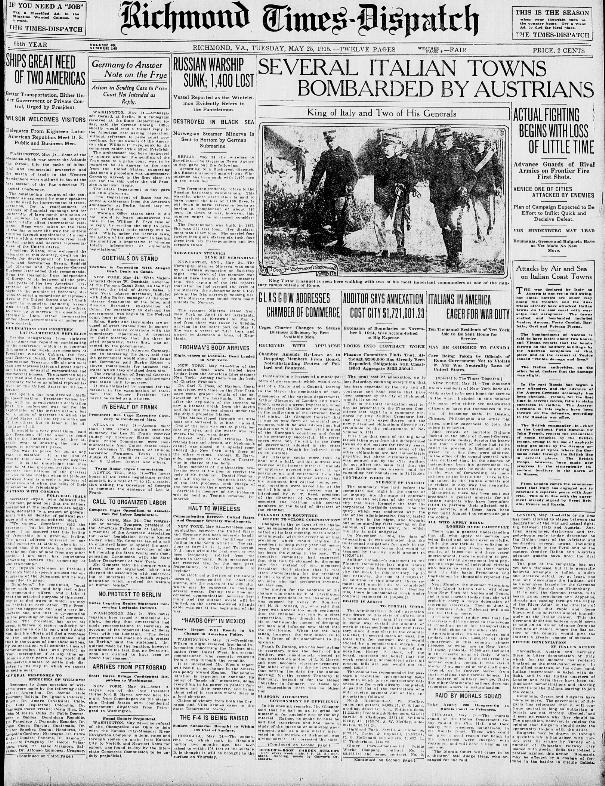|
Moderated by NW Okie! |
Volume 17 , Issue 162015Weekly eZine: (371 subscribers)Subscribe | Unsubscribe Using Desktop... |
100 Years Ago, 25 May 1915, Tuesday

One hundred years ago today, 25 May 1915, Tuesday, the Richmond Times-Dispatch, out of Richmond, Virginia, had front page headlines concerning World War I, with additional news of the sinking of the Lusitania and other ship sunk on that date.
One of those ships was a Norwegian Steamer Minerva that was sent to the bottom by German submarine. According to a Bucharest dispatch, the Russian armored man-of-war Winteleimon had been sunk with 1,400 men in the Black Sea.
The Russian battleship Panteleimon, warship was said to have caused the loss of 1,400 lives and was put down in naval reference books as having a complement of about 740 men.
The Panteleimon was built in 1897, 387 feet long. Her displacement was 12,582 tons, carrying four twelve inch guns, sixteen six inch, four three inch, six three pounders and five torpedo tubes.
The Norwegian Steamer
Newcastle, Eng., May 24 (1915) -- The Norwegian Steamer Minerva was sunk by a German submarine on that Saturday night, 24 May 1915. The crew of the steamer was landed in Newcastle that night by the steamer Iris. The captain of the Iris reports that after he had rescued the crew of the Minerva, the submarine sent a torpedo at the Iris, narrowly missing her. The Minerva was bound from South Shields for Norway.
The steamer Minerva sailed from New York on 16 April 1915 for Kirstiania. She arrived at Kirkwall on 4 May, and from there was taken to Shields, arriving in the latter pro on May 8. She was a vessel of 2,423 tons, and owned by Jacobson & Sons, of Kristiania.
Frohman's Body Arrives
New York, May 24 (1915) -- Nine of the Lusitania's dead were landed in New York that date from the American Line Steamer New York. Among them was the body of Charles Frohman. Eight others of Lusitania Dead landed, also.
Dr. Carl E. Foss, of Harlem, Montana, a survivor, who came on the New York, gave some graphic details of the destruction of the Lusitania. He said after the explosion of the torpedo he saw a lifeboat break from the davits and fall into the sea almost under the big ship's propellor blades.
The blades ripped through the little boat and battered it to bits. One of the men was cut to pieces before his eyes, and the water was red where the boat went down.
Banked with floral tributes from friends in New York and abroad, Mr. Frohman's casket was placed in a special room aboard the New York with those of the other victims. Robert H. Burnside, manager of the Globe Theater, was in charge of the body.
Many members of the theatrical profession were at the pier to receive the body of Mr. Frohman. Daniel Frohman and Alf Hayman, a business associate of the late producer, took charge of the remains on their arrival.
| View or Add Comments (0 Comments)
| Receive
updates ( subscribers) |
Unsubscribe
| © . Linda Mcgill Wagner - began © 1999 Contact Me | |
